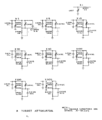Turret attenuators: Difference between revisions
Jump to navigation
Jump to search
(cat) |
Vintage dave (talk | contribs) (heat sensitivity) |
||
| (One intermediate revision by one other user not shown) | |||
| Line 1: | Line 1: | ||
Turret | In a '''Turret attenuator''', individual R/C attenuator elements are rotated within a cylindrical housing whereas the external contacts stay stationary. | ||
They were used in the [[H|Type H]], [[Z|Type Z]], [[516]], and [[1121]] and are known to give trouble in the form of intermittent electrical continuity at the contacts. | |||
Also, the plastic used in the turrets is easily melted if a soldering iron gets anywhere near it. | |||
<gallery> | <gallery> | ||
Tek 1121 turret attenuator.jpg|Turret attenuator of a [[1121]] | |||
Tek 516 turret.jpg | [[516]] | |||
Tek_z_turret.png | Type Z attenuators circuits | |||
</gallery> | </gallery> | ||
[[Category:Electromechanical components]] | [[Category:Electromechanical components]] | ||
[[Category:Repair issues]] | [[Category:Repair issues]] | ||
Latest revision as of 19:31, 27 March 2022
In a Turret attenuator, individual R/C attenuator elements are rotated within a cylindrical housing whereas the external contacts stay stationary.
They were used in the Type H, Type Z, 516, and 1121 and are known to give trouble in the form of intermittent electrical continuity at the contacts. Also, the plastic used in the turrets is easily melted if a soldering iron gets anywhere near it.
-
Turret attenuator of a 1121
-
Type Z attenuators circuits


